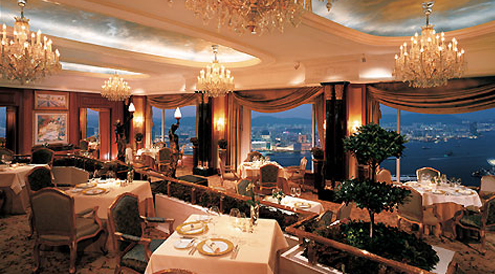
About twenty-five years ago, fine dining in Hong Kong consisted of only a handful of options: Plume at the Regent Hotel, The Grill Room at the Hilton, Gaddi’s at the Peninsula or Margaux at the Kowloon Shangri-la. It was at these restaurants where one could find a decent wine list. Back in the 1980s, it was Tsim Sha Tsui not Central that had the majority of fine dining options.
Wine’s groupies were rather limited among the Chinese at that time and the majority consisted of lawyers and doctors who had studied in England developing a taste for claret and Chablis. The cost of wine was expensive but not prohibitive among the white collared professionals and amassing a modest cellar did not require a fortune. Despite the relative affordability (compared to the cost of fine wines now), the image of wine was always elitist, associated with the expatriate community, the then governing British upper class and those who were fortunate enough to have studied abroad.
Even now, with numerous wines priced at under HK$100 at Park N Shop and Wellcome, wine is still in the minds of many people, a luxury beverage. It is easy to understand why: Wine still costs more than beer and many other beverages; it is not considered an essential part of a meal as it is in many wine producing regions; historically, it has been associated with the elite and affluent class; it possesses unique characteristics that allow it to age and increase in value; its understanding and appreciation is shrouded with complex jargon and facts. All of this contributes to wine being firmly placed in the minds of many as a luxury product even if prices have come down to much more affordable levels.
Wine as part of a luxury dining experience enjoys its own special serving ceremony. First there are the glasses and decanters to select – e.g Riedel makes a different wine glass for each major grape variety and region. For optimal enjoyment, the correct temperature of the wine is crucial and this often requires a temperature controlled storage unit to house the wines until they are ready to be served. Ice buckets and other serving paraphernalia such as different types of wine openers (for normal wine, for mature wines, etc) need to be prepared. It is often desirable to have wine fridges, which allow wine to be stored without the usual vibrations found in normal refrigerating units.
The ‘wine ceremony’ is often entrusted to a sommelier who is well-versed in the wine serving ritual. An experienced sommelier would first present the bottle to the customer for inspection, then skillfully with a knife remove the top part of the capsule. The next step exposes the experience of the sommelier how easily does he/she extract the cork from the bottle? Is it done in one smooth effortless gesture or is there a struggle to remove the cork? Next, the cork is presented to the customer for inspection and a small tasting portion is either poured for the sommelier to determine if the wine is in the correct condition to be served or the tasting portion is served to the customer for them to make that determination. All of this occurs before the wine is even consumed.
In very much the same way, luxury products have their own selling ceremony. The experience of walking into a grand flagship luxury store such as Louis Vuitton or Giorgio Armani is as controlled and detailed as the wine service ceremony. Each item and product has been carefully reviewed to fit the needs of the market, the sales people have been trained in the multiple languages of the local market and they understand the unique characteristics and details necessary to communicate and sell luxury products. The complete the experience the desired ambience with flattering lighting, artful displays and eye-catching decoration provide the backdrop for the luxury purchasing experience.
The rituals and ceremonies surrounding luxury products play an important role in creating an aura of importance befitting the product’s price tag and quality. Trying to remove the snob factor out of wine, it’s sensible to question whether wine actually needs all these accoutrements for enjoyment. On the one hand, even without a sommelier meticulously handling and serving the wine, we can obtain pleasure from what is inside the bottle. We don’t need glasses for every different grape variety and we really only need one good wine opener and not more.
However, there are many aspects of the serving ceremony that are essential to our enjoyment: the correct temperature for storing and serving and the initial tasting assessment to determine if the wine is sound and can be served to everyone. A good sommelier is also a useful guide who is able to navigate their wine list with ease and make recommendations depending on different customer’s budgets and preferences.
Wine has all the trappings of a complex luxury product. But don’t forget that for many Europeans, it is just a beverage to be enjoyed with food. Wine is both a luxury as well as a mass market product and the great news for us is that it offers a huge variety of styles at all different price points.
Reprinted with permission from South China Morning Post









